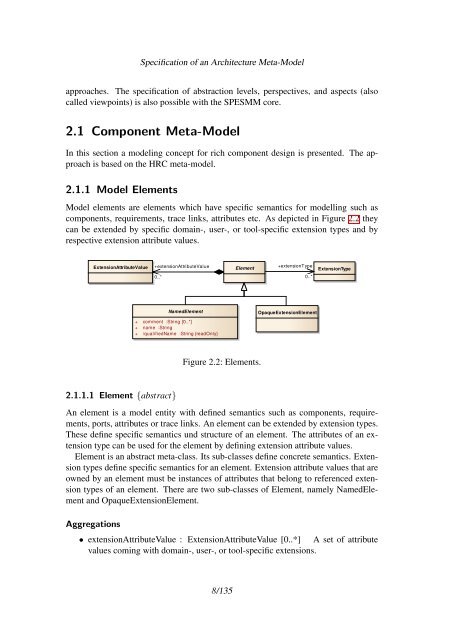Specification of an Architecture Meta-Model - SPES 2020
Specification of an Architecture Meta-Model - SPES 2020
Specification of an Architecture Meta-Model - SPES 2020
Create successful ePaper yourself
Turn your PDF publications into a flip-book with our unique Google optimized e-Paper software.
<strong>Specification</strong> <strong>of</strong> <strong>an</strong> <strong>Architecture</strong> <strong>Meta</strong>-<strong>Model</strong><br />
approaches. The specification <strong>of</strong> abstraction levels, perspectives, <strong>an</strong>d aspects (also<br />
called viewpoints) is also possible with the <strong>SPES</strong>MM core.<br />
2.1 Component <strong>Meta</strong>-<strong>Model</strong><br />
In this section a modeling concept for rich component design is presented. The approach<br />
is based on the HRC meta-model.<br />
2.1.1 <strong>Model</strong> Elements<br />
<strong>Model</strong> elements are elements which have specific sem<strong>an</strong>tics for modelling such as<br />
components, requirements, trace links, attributes etc. As depicted in Figure 2.2 they<br />
c<strong>an</strong> be extended by specific domain-, user-, or tool-specific extension types <strong>an</strong>d by<br />
respective extension attribute values.<br />
ExtensionAttributeValue +extensionAttributeValue<br />
+extensionType<br />
Element<br />
ExtensionType<br />
0..*<br />
2.1.1.1 Element {abstract}<br />
NamedElement<br />
+ comment :String [0..*]<br />
+ name :String<br />
+ /qualifiedName :String {readOnly}<br />
Figure 2.2: Elements.<br />
0..*<br />
OpaqueExtensionElement<br />
An element is a model entity with defined sem<strong>an</strong>tics such as components, requirements,<br />
ports, attributes or trace links. An element c<strong>an</strong> be extended by extension types.<br />
These define specific sem<strong>an</strong>tics und structure <strong>of</strong> <strong>an</strong> element. The attributes <strong>of</strong> <strong>an</strong> extension<br />
type c<strong>an</strong> be used for the element by defining extension attribute values.<br />
Element is <strong>an</strong> abstract meta-class. Its sub-classes define concrete sem<strong>an</strong>tics. Extension<br />
types define specific sem<strong>an</strong>tics for <strong>an</strong> element. Extension attribute values that are<br />
owned by <strong>an</strong> element must be inst<strong>an</strong>ces <strong>of</strong> attributes that belong to referenced extension<br />
types <strong>of</strong> <strong>an</strong> element. There are two sub-classes <strong>of</strong> Element, namely NamedElement<br />
<strong>an</strong>d OpaqueExtensionElement.<br />
Aggregations<br />
• extensionAttributeValue : ExtensionAttributeValue [0..*] A set <strong>of</strong> attribute<br />
values coming with domain-, user-, or tool-specific extensions.<br />
8/135
















